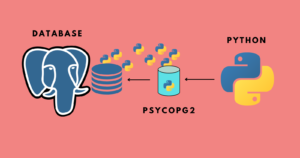Have you ever heard the word “parallel iteration” or tried to “loop over multiple iterables in parallel” when you were coding in Python?
This tutorial will show a Python zip() function that helps us perform a parallel iteration over multiple iterables.
Definition
The zip() function takes iterables and iterates over them parallelly, which results in producing tuples of each item from the iterables.
|
1 2 3 4 5 6 |
items = ["Computer", "Keyboard", "CPU", "Mouse"] units = [3, 2, 4, 6] mapping = zip(items, units) print(tuple(mapping)) |
Output
|
1 |
(('Computer', 3), ('Keyboard', 2), ('CPU', 4), ('Mouse', 6)) |
In other words, it returns the iterator of tuples where the first item in each passed iterator is paired together and then the second item in each passed iterator is paired together and it goes so on until the shortest iterator is exhausted.
Another way to think of
zip()is that it turns rows into columns and columns into rows. This is similar to transposing a matrix.Source
Syntax
The syntax of Python zip() function is:
zip(*iterables) or zip(iterator1, iterator2, ...)
In Python 3.10, the strict argument was added
zip(*iterables, strict=False)
We’ll see the use of strict ahead in this tutorial.
zip() parameters:
iterables: they can be lists, tuples, dictionaries, or objects that can be iterated.
Example
|
1 2 3 4 5 6 7 8 |
languages = ["Python", "JavaScript", "C", "C++"] founded = [1991, 1995, 1972, 1985] mapping = zip(languages, founded) print(list(mapping)) print(type(list(mapping))) |
Output
|
1 2 |
[('Python', 1991), ('JavaScript', 1995), ('C', 1972), ('C++', 1985)] <class 'list'> |
Working of zip() function
How zip() function creates an iterator of the tuple?
We can actually say that zipping means aggregating two separate things into one.
Just like it, the Python zip() function works by taking two inputs say A1 and A2, and then aggregating the item of the same index number of A1 and A2.
We will better understand through the illustration below

- We can clearly see, on the right side – the tuple at the 0th index contains each item of
A1andA2at the 0th index respectively. - The same goes for items at the 1st index of
A1andA2. - In general, the tuple at the index
icontains items at the indexiinA1andA2.
More formally: zip() returns an iterator of tuples, where the i-th tuple contains the i-th element from each of the argument iterables.Source
Iterables of different lengths
What happens if iterables are of different lengths?
Nothing’s gonna happen if the iterables passed to the zip() function have different lengths because if we refer to official Python docs then it states that “the iterator stops when the shortest iterable is exhausted”.
Example
|
1 2 3 4 5 6 |
languages = ["Python", "JavaScript", "C", "C++"] founded = [1991, 1995, 1972] mapping = zip(languages, founded) print(list(mapping)) |
Output
|
1 |
[('Python', 1991), ('JavaScript', 1995), ('C', 1972)] |
Here, the C++ was excluded because the founded variable contains only three arguments.
What if Python throws an error when the iterables are of different lengths?
Let’s understand with an example
|
1 2 3 4 5 6 |
languages = ["Python", "JavaScript", "C", "C++"] founded = [1991, 1995, 1972] mapping = zip(languages, founded, strict=True) print(list(mapping)) |
Output
|
1 2 3 |
Traceback (most recent call last): .... ValueError: zip() argument 2 is shorter than argument 1 |
Did you notice that there is an additional argument strict=True in the code?
The strict argument is added in Python version 3.10
If the iterables have different lengths and we use the strict argument, the code will throw a ValueError. It can be useful for debugging.
Passing one or no iterable to the zip()
The zip() function will return an empty iterator if no parameters were passed.
|
1 2 |
no_iterable = zip() print(list(no_iterable)) |
Output
|
1 |
[] |
If we pass only one iterable, then the zip() function will return an iterator of tuples each having only one element.
|
1 2 3 4 5 |
languages = ["Python", "JavaScript", "C", "C++"] mapping = zip(languages) print(list(mapping)) |
Output
|
1 |
[('Python',), ('JavaScript',), ('C',), ('C++',)] |
Python zip() Examples
Example: Using enumerate() function with zip()
|
1 2 3 4 5 6 7 |
characters = ["Iron Man", "Thor", "Spiderman"] real_names = ["RDJ", "Chris Hemsworth", "Andrew Garfield"] result = zip(characters, real_names) for num, results in enumerate(result): print(num, results) |
Output
|
1 2 3 |
0 ('Iron Man', 'RDJ') 1 ('Thor', 'Chris Hemsworth') 2 ('Spiderman', 'Andrew Garfield') |
Example: Using range() function
|
1 2 3 4 5 |
name = ["Sachin", "Rishu", "Yashwant", "Abhishek"] values = zip(range(4), name) print(tuple(values)) |
Output
|
1 |
((0, 'Sachin'), (1, 'Rishu'), (2, 'Yashwant'), (3, 'Abhishek')) |
Example: Having multiple iterables
|
1 2 3 4 5 6 7 |
characters = ["Iron Man", "Thor", "Spiderman"] real_names = ["RDJ", "Chris Hemsworth", "Andrew Garfield"] reel_names = ["Tony Stark", "Thor", "Peter Parker"] result = zip(characters, real_names, reel_names) print(list(result)) |
Output
|
1 |
[('Iron Man', 'RDJ', 'Tony Stark'), ('Thor', 'Chris Hemsworth', 'Thor'), ('Spiderman', 'Andrew Garfield', 'Peter Parker')] |
Example: Typecasting into different data types
Typecasting into List
|
1 2 3 4 5 6 |
characters = ["Iron Man", "Thor", "Spiderman"] real_names = ["RDJ", "Chris Hemsworth", "Andrew Garfield"] result = zip(characters, real_names) print(f"List: {list(result)} and type is {type(list(result))}") |
Output
|
1 |
List: [('Iron Man', 'RDJ'), ('Thor', 'Chris Hemsworth'), ('Spiderman', 'Andrew Garfield')] and type is <class 'list'> |
Typecasting into Dictionary
|
1 2 3 4 5 6 |
characters = ["Iron Man", "Thor", "Spiderman"] real_names = ["RDJ", "Chris Hemsworth", "Andrew Garfield"] result = zip(characters, real_names) print(f"Dictionary: {dict(result)} and type is {type(dict(result))}") |
Output
|
1 |
Dictionary: {'Iron Man': 'RDJ', 'Thor': 'Chris Hemsworth', 'Spiderman': 'Andrew Garfield'} and type is <class 'dict'> |
Typecasting into Set
|
1 2 3 4 5 6 |
characters = ["Iron Man", "Thor", "Spiderman"] real_names = ["RDJ", "Chris Hemsworth", "Andrew Garfield"] result = zip(characters, real_names) print(f"Set: {set(result)} and type is {type(set(result))}") |
Output
|
1 |
Set: {('Iron Man', 'RDJ'), ('Spiderman', 'Andrew Garfield'), ('Thor', 'Chris Hemsworth')} and type is <class 'set'> |
Typecasting into Tuple
|
1 2 3 4 5 6 |
characters = ["Iron Man", "Thor", "Spiderman"] real_names = ["RDJ", "Chris Hemsworth", "Andrew Garfield"] result = zip(characters, real_names) print(f"Tuple: {tuple(result)} and type is {type(tuple(result))}") |
Output
|
1 |
Tuple: (('Iron Man', 'RDJ'), ('Thor', 'Chris Hemsworth'), ('Spiderman', 'Andrew Garfield')) and type is <class 'tuple'> |
Unzipping the Values
We can actually unzip the values that were already zipped. Let’s see how to do so.
This can be done with the help of * asterisk operator.
Let’s understand with an example.
|
1 2 3 4 5 6 7 8 9 10 11 12 13 14 15 16 17 18 19 20 21 22 |
characters = ["Iron Man", "Thor", "Spiderman"] real_names = ["RDJ", "Chris Hemsworth", "Andrew Garfield"] reel_names = ["Tony Stark", "Thor", "Peter Parker"] mapping = zip(characters, real_names, reel_names) mapped = list(mapping) print(f"Zipped result: {mapped}", end="") print("\n") # unzipping values char, real, reel = zip(*mapped) print("Unzipped result:") print(f"The characters list is : {char}") print(f"The real_names list is : {real}") print(f"The reel_names list is : {reel}") |
Output
|
1 2 3 4 5 6 |
Zipped result: [('Iron Man', 'RDJ', 'Tony Stark'), ('Thor', 'Chris Hemsworth', 'Thor'), ('Spiderman', 'Andrew Garfield', 'Peter Parker')] Unzipped result: The characters list is : ('Iron Man', 'Thor', 'Spiderman') The real_names list is : ('RDJ', 'Chris Hemsworth', 'Andrew Garfield') The reel_names list is : ('Tony Stark', 'Thor', 'Peter Parker') |
Notice how we unzipped the values of the variable mapped using * and to store the unzipped values we declared three variables char, real and reel
Conclusion
In this tutorial, you’ve learned to perform a parallel iteration using Python’s zip() function and I hope you understand how to use it.
You now understand how the zip() function works behind the scenes to generate a tuple iterator.
Try the code snippets written above in your IDEs to understand the code better.
🏆Other articles you might be interested in if you liked this one
✅How to convert bytes into strings in Python?
✅f-string: An improved and modern way of string formatting.
✅How to access the list values within the dictionary in Python?
✅How to use __str__ and __repr__ to change the string representation of the objects in Python?
✅How do sort() and sorted() functions are different from each other?
✅What is the difference between seek() and tell() in Python?
✅How to use tempfile module to create temporary files and dirs in Python?
That’s all for now.
Keep Coding✌✌





